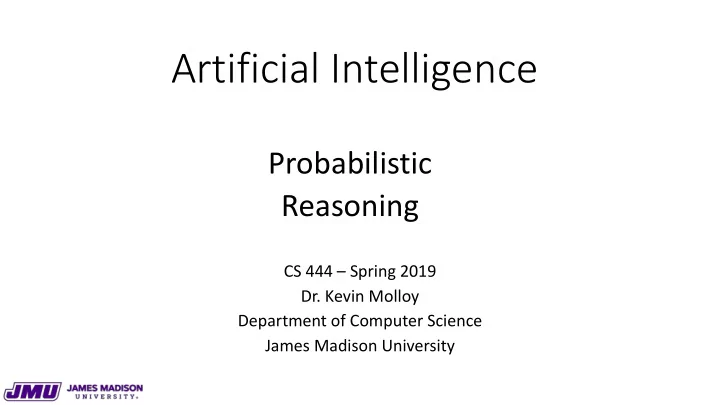

Artificial Intelligence Probabilistic Reasoning CS 444 – Spring 2019 Dr. Kevin Molloy Department of Computer Science James Madison University
Bayesian Networks A simple, graphical notation for conditional independence assertions and hence for compact specification of full joint distribution Syntax: • A set of nodes, one per variable • A directed, acyclic graph (link is approximately "directly influences") • a conditional distribution for each node given its parents P(X i | Parents(X i )). In the simplest case, conditional distribution represented as a conditional probability table (CPT) giving the distribution over X i for each combination of parents values.
Example of a Bayesian Networks Topology of network encodes conditional independence assertions: Weather is independent of the other variables Toothache and Catch are conditionally independent given Cavity .
Example of a Bayesian Networks I'm at work, neighbor John calls to say my alarm is ringing, but my neighbor Mary doesn't call. Sometimes it's set off by monitor earthquakes. Is there a burglar? Variables: Burglar, Earthquake, Alarm, JohnCalls, MaryCalls Network topology reflects "causal" knowledge: • A burglar can set off the alarm • An earthquake can set the alarm off • The alarm can cause Mary to call • The alarm can cause John to Call.
Example of a Bayesian Networks
Compactness A CPT for Boolean X i with k Boolean parents. Has: 2 k rows for the combinations of parent values Each row requires on number p for X i = true (the number for X i = false is simply 1 – p) If each variable has no more than k parents, the complete network requires O(n · 2 k ) numbers i.e. grows linearly with n, vs O(2 n ) for the full joint distribution. For the burglary net, 1 + 1 + 4 + 2 + 2 = 10 numbers (vs. 25 – 1 = 31).
Global Semantics Global semantics defines the full joint distribution as the product of the local conditional distributions. ' !(# $ , … , # ') = * ! # + -./0123 (4 + )) +,$ e.g. P(j ∧ m ∧ a ∧ ¬b ∧ ¬e) = P(j |a )P(M | a) P (a | ¬b, ¬e)P(¬b) P(¬e) = 0.9 x 0.7 x 0.001 x 0.999 x .998 ≈ 0.00063
Local Semantics Local semantics: each node is conditionally independent of its nondescenants given its parents Theorem: Local semantics ⇔ global semantics
Markov Blanket Each node is conditionally independent of all others given its Markov blanket: parents + children + children's parents
Constructing a Bayesian Network Need a method such that a series of locally testable assertions of conditional independence guarantees the required global semantics 1. Choose an ordering of variables: X 1 , … , X n 2. For I = 1 to n • Add X i to the network • Select parents from X 1 , … , X i-1 such that P(X i | Parents(X i )) = P(X i | X 1 , …, X i-1 ) This choice of parents guarantees the global semantics
Example Suppose we choose the ordering M, J, A B, E P(J | M) = P(J). No.
Example Suppose we choose the ordering M, J, A B, E P(J | M) = P(J). No. P(A | J, M) = P(A|J) P(A|J,M) = P(A)
Example Suppose we choose the ordering M, J, A B, E P(J | M) = P(J). No. P(A | J, M) = P(A|J) P(A|J,M) = P(A). No. P(B | A, J, M) = P(B, A)? P(B | A, HJ, M) = P(B)?
Example Suppose we choose the ordering M, J, A B, E P(J | M) = P(J). No. P(A | J, M) = P(A|J) P(A|J,M) = P(A). No. P(B | A, J, M) = P(B, A)? Yes. P(B | A, HJ, M) = P(B)? No. P(E|B, A, J, M) = P(E | A)? P(E |B, A, J, M) = P(E| A, B)?
Example Suppose we choose the ordering M, J, A B, E P(J | M) = P(J). No. P(A | J, M) = P(A|J) P(A|J,M) = P(A). No. P(B | A, J, M) = P(B, A)? Yes. P(B | A, HJ, M) = P(B)? No. P(E|B, A, J, M) = P(E | A)? No. P(E |B, A, J, M) = P(E| A, B)? Yes.
Example Deciding conditional independence is hard in noncausal directions (causal models and conditional independence seem hardwired for humans!). Assessing conditional probabilities is hard in noncausal directions, resulting in the network being less compact: 1 + 2 + 4 + 2 + 4 = 13 numbers needed
Example: Car Diagnosis Initial evidence: car won't start Testable variables (Green), "Broken, so fix it" variables are orange Hidden variables (gray) ensure sparse structure, reduce parameters
Example: Car Insurance
Compact Conditional Distributions CPT grows exponentially with number of parents CPT becomes infinite with continuous-valued parent or child
Some Exercises We have a bag of 3 biased coins: a, b, c with probabilities of coming up heads of 20%, 60%, and 80% respectively. One coin is drawn radmonly from the bag (with equal likelihood od drawing each of the 3 coins), and then the coin is flipped 3 times to generate the outcomes X 1 , X 2 , and X 3 . 1. Draw the Bayesian network corresponding to this setup and define the necessary CPTs. 2. Calculate which coin was most likely to have been drawn from the bag if the observed flips come out heads twice and tails once.
Some Exercises Consider this Bayesian network. 1. If no evidence is observed, are Burglary and Earthquake independent? Explain why/why not. 2. If we observe Alarm = true, are Burglary and Earthquake independent? Justify your answer by calculating whether the probabilities involved satisfy the definition of conditional independence.
Recommend
More recommend